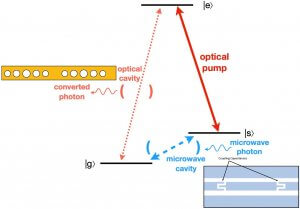Summary
In this project we develop a quantum interface between microwave and optical photons as a key enabling technology of a hybrid quantum network. In such a network, the robust optical photons carry quantum information through optical fibres over long distances, while superconducting microwave circuits protected from thermal photon noise by the low temperature environment of a dilution refrigerator function as quantum nodes, providing memory, processing and routing capability. Our work includes developing an integrated, microfabricated device that interfaces the fragile microwave photons and with optical photons through either individual or ensembles of three-level solid-state quantum emitters, such as nitrogen vacancy (NV) centers in diamonds. In addition, we are developing novel quantum memory and repeater designs. Here the device itself could serve as an optical quantum memory, storing information in the ground states where we may perform quantum control via a microwave circuit. It could also serve as a specialized quantum node. Entangling operations between remote superconducting circuits can be performed for repeater operation. Finally, we will also develop an efficient microwave photon detector that works by converting microwave photons into optical photons, which can then be efficiently detected with existing technology.

Figure 1. Microwave to optical conversion with a three level quantum emitter coupled to a microwave stripline cavity and an optical, e.g. a photonic-crystal, cavity: A microwave photon couples the two ground states |g> and |s> of a three-level quantum emitter with the help of the microwave cavity. The conversion is then completed through an optical pump and an enhanced emission into optical cavity coupled to the transition between the excited state |e> and the ground state |g>.
Related Content

Quantum Information Processing with Molecular Lattices
The aim of the work is to develop theoretical tools to simulate and predict the behaviour of a one-dimensional chain of trapped dipolar molecules and to study the nature of entanglement as a design resource.
June 1, 2017
Advanced microwave electronics enabling quantum technologies
Summary Superconducting quantum computers require quantum-limited measurements at microwave frequencies in order to implement error correction. Conventionally, this is accomplished using near quantum-limited Josephson Parametric Amplifiers (JPAs). The JPAs require bulky ferrite-based circulators that prevent on-chip integration of the amplifiers with the processor and take up the majority of space and cooling power in the […]
April 1, 2020

Quantum Simulation of Strongly Coupled Field Theories
Strongly-coupled field theories describe both fundamental and applied quantum problems.
August 10, 2017

Developing Tools for Quantum Characterization and Validation
Summary Coherence is essential for quantum computation; yet it introduces a unique sensitivity to any imperfections in hardware design, control systems, and the operating environment. Overcoming these sensitivities requires a hierarchy of strategies, ranging from optimization of the hardware architecture to software solutions including quantum error correction. Randomized Benchmarking Protocols are an important family of […]
October 3, 2017

